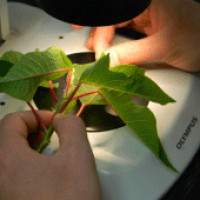- Home › Flower Growers › Grower News › Sterile Insect Technique to Control Leafminer


Using the Sterile Insect Technique (SIT) to Control Leafminer (Liriomyza trifolii) in Ornamental Greenhouses
Ornamental crops have a low damage threshold and leafminer feeding and tunneling in foliage is highly visible. Unfortunately, extensive use of insecticides has led to pesticide resistance, with some leafminer populations in Ontario developing resistance to at least two registered insecticides. While biological control agents, such as Diglyphus isaea have been used to suppress leafminer in ornamental greenhouses, application of registered insecticides may negatively affect the establishment of D. isaea.
The Sterile Insect Technique (SIT) has been advocated as a potential non-chemical alternative to conventional pest management methods. Flowers Canada (Ontario) Inc. is funding research at the University of Guelph to develop a method for the use of SIT to control leafminers in ornamental greenhouses.
Please take a few minutes for a short survey for growers who have or are currently experiencing leafminer problems. The goal of this survey is to assess the extent of leafminer infestations in ornamental greenhouses and to determine the type and effectiveness of current control methods.
It would be greatly appreciated if you could give us a few moments of your time to fill out this survey (click here).
SIT Explained:
The Sterile Insect Technique (SIT) has been utilized since the 1950’s when two American scientists used the approach to eliminate screwworms (Cochliomyia hominivorax). Today, this method is used around the world to control a variety of insect pests.
The concept behind SIT involves sterilizing large numbers of a particular insect species, using radiation. The sterile insects are then released into the environment (or greenhouse), where they outnumber their wild, fertile counter parts and thereby out compete them during mating. Since most damage is done by females, the method generally involves sterilizing males which then mate with wild, fertile females. A cross between a sterile male and a fertile female will result in an unviable egg. When large numbers of unviable eggs are created, fewer larvae will emerge and less damage to crops occurs. Over time, this method can significantly reduce the insect population in the treated area. SIT can be considered environmentally responsible pest management approach because:
- SIT will not leave behind any pesticide residues,
- SIT is specific to the targeted species and will not adversely impact any pollinators or beneficial insects,
- Sterile insect do not emit any kind of radiation.
The diagram below provides some more details on how SIT could be applied to control leafminers in ornamental greenhouses in Canada:

Categories
Event Calendar
The Latest from Greenhouse Canada
Dipping Cuttings to Start Clean
Vineland researchers are working with Flowers Canada and OMAF & MRA to get cutting dips on the labels.Hitchhiking whitefliesPoinsettia…



